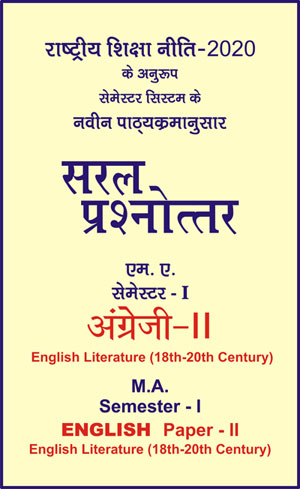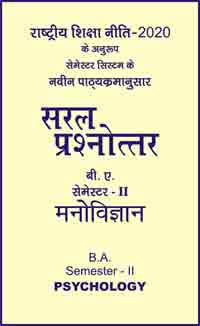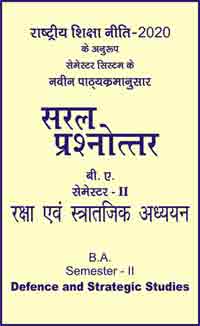|
बी ए - एम ए >> एम ए सेमेस्टर-1 - अंग्रेजी - द्वितीय प्रश्नपत्र - अंग्रेजी साहित्य 18वीं-20वीं शताब्दी एम ए सेमेस्टर-1 - अंग्रेजी - द्वितीय प्रश्नपत्र - अंग्रेजी साहित्य 18वीं-20वीं शताब्दीसरल प्रश्नोत्तर समूह
|
5 पाठक हैं |
|||||||
एम ए सेमेस्टर-1 - अंग्रेजी - द्वितीय प्रश्नपत्र - अंग्रेजी साहित्य 18वीं-20वीं शताब्दी
Question- What do you think of the various women that come in Stephen's life in the novel?
Answer -
Apart from his mother and Dante, the first-person from the opposite sex who figures in Stephen's life is Eileen. It is her white hands and golden hair that first stir his boyish notion about girls. His relationship with Eileen is not shown as amounting to much in the ultimate analysis. Then there are the romantic dreams about Mercedes (a character from the novel The Count of Monte Cristo by Alexander Dumas). She is the beloved of the novel's hero Edmond Dantes. Stephens pictures himself grandly rejecting her because she had earlier sighted his love. The next person from the opposite sex to figure in Stephen's life is Emma whom he meets at the party at Harold Cross. With drawing from the other children, he relishes his isolation. Emma glances repeatedly and invitingly in his direction. She gives rise to a feverish excitement in Together they take the last tram home. They stand on the steps of the tram. He is on a step above hers. As they talk, she keeps coming up to join him on his step. He knows that she is making an advance to him. And yet he is unable to respond in kind. The failure bothers him but all that comes out of it is an attempt to write a poem to Emma.
Two year laters there is a school- play in which Stephen figures. He works himself up into an excited romantic mood anticipating a meeting with Emma after she has seen the play. The whole thing collapses when he does not find Emma in the audience. The sexuality that might have found an outlet through this relationship is diverted elsewhere culminating in his experience with the prostitute. In this experience he is able to find not only relief from the goadings of his lust but a new self-assurance. After a cycle of sin and guilt the wading girl becomes for him a way out of his dilemma. She becomes the catalytic agent for creativity.
In the final chapter, Stephen imagines that Emma flirts with Father Moran. And yet the sight of her near the entrance of the library gives use to the thought that she might be innocent. There is a surge of emotions but much does not come out of it. He does write a poem to her and pictures her in remorse. When Emma ignores him outside the library he thinks that she is consciously rebuffing him and that cleanly is pursuing her. The diary jottings at the end tell us that she has been wanting to make contact with him. She wants to know why she sees so little of him and whether he still writes poems. His reply is a rebuff, aimed at embarrassing her. And yet he cannot fully get over the attraction he feels for her. It is another thing that the call for exiling himself to which his soul responded makes him push her (temporarily) to the back of his mind.
Essentially, Stephen's inability to connect fully with girls of his age is tied up with his aloofness from most his compatriots at school and university. It is partly timidity and partly a feeling of self importance which prevents him from reaching out to people. His 'notions' about what an 'artist' should be like, also contribute to his isolation. In general, his encounters with the girls are awkward and unsatisfactory. The fallout quite often is that he submits to crude sexual fantasies.
For the larger part of the novel, Stephen is unable to think of woman except in fixed, polarised terms. Most of the time Stephen is able to come to terms with woman symbolically as a strong maternal figure (even the prostitute, in a sense, mothers him). His clumsy response to Emma towards the end of the novel is a function of a monk like withdrawl into the spiritual- heroic refrigerating apparatus that he has. The pre eminence of the virgin/ mother model prevents Stephen from approaching woman comprehensive and inclusive terms through woman is represented in A Portrait in a wide range of figures and images.
We can conclude that, in general terms, 'woman' as image can be seen as having two contradictory (and almost mutually exclusive) sets of meaning. At one level woman' is possessive and a kind of stumbling block where Stephen's progress toward freedom and creative art is concerned. His mother largely and Eileen, Mercedes and E.C. partly belong here. At the other level 'Woman' is a source of freedom and enlightenment. The wading girl and before her the prostitute belong to this category.
|
|||||
- Question- Describe Social and Historicals movements of post modern world wars (I & II).
- Question- Explain the meaning of Romanticism and the Romantic period.
- Question- What is Industrial revolution? Give its main characteristics.
- Question- Write a short biography of John Stuart Mill.
- Question- Write a detail note about Darwinism.
- Question- What do you know about modernism in English Literature?
- Question- What are some main characteristic features of modernism or in modernist literature?
- Question- What do you know about Modernism in Literature? Study it under the following heads- 1. Modern Fiction 2. Modem Poetry 3. Modern Drama.
- Question- What was the 20th century known for?
- Question- What is the theme of 20th century literature?
- Question- Write a note on 'Subjection of women'
- Question- Provide a summary on The Subjection of women chapter I'.
- Question- What is the structure of the Subjection of women?
- Question- What is social and legal status of women?
- Question- Describe Arnold as a prose writer.
- Question- "The pursuit of perfection is the pursuit of sweetness and light". Elucidate.
- Question- How does Arnold say that culture and religion are not in conflict with each other?
- Question- What is according to Arnold the ultimate goal of culture?ply
- Question- How does Arnold criticise the Puritans?
- Question- Write a note on the contribution made to English thought by Ruskin.
- Question- Describe characteristics of Ruskin's socialism.
- Question- Write the summary of the essay The Roots of Truth from "Unto The Last" by John Ruskin.
- Question- Write a note on Ruskin as an art critic.
- Question- Summarise Ruskin's views in Lecture on Work.
- Question- Attempt a critical Analysis of "The Queen's Looking Glass" Written by Gilbert and Gubar.
- Question- Describe the looking glass reveals the existence of patriarchy throughout various fairytales.
- Question- What are the different ways in which women tend to immerse themselves in unhealthy obsessions, and why do they do this?
- Question- What are some of the central dilemmas facing the "independent woman" in de Beauvoir's time?
- Question- How does de Beauvoir respond to those who believe that granting women greater equality means losing the "spice" of life?
- Question- Write a detailed note on Jean-Paul Sartre.
- Question- Write an essay on Existentialism and The Human Emotions.
- Question- Provide a background to Albert Camus's Myth of Sisyphus.
- Question- Provide a summary of the myth of Sisyphus.
- Question- What do you know about Myth of Sisyphus Chapter 1?
- Question- Write a short note on the life-sketch of Albert Camus.
- Question- Evaluate 'Rape of the Lock' as a mock heroic epicpoem.
- Question- What picture of the eighteenth century social life do we find in 'the Rape of the Lock'.
- Question- What did Belinda see in her sleep?
- Question- Discuss Clarrisa's speech in "The Rape of the Lock".
- Question- What items of toiletry stood displayed on Belinda's table in Canto I of "The Rape of the Lock'?
- Question- Discuss Wordsworth's contribution to English criticism.
- Question- Give a critical estimate of Wordsworth's 'Preface to Lyrical Ballads'.
- Question- Summarise William Wordsworth's views on Appendix on poetic diction.
- Question- Write a critical Appreciation of the poem "Tintern Abbey".
- Question- How is "The Rime of the Ancient Mariner' a romantic poem?
- Question- What are some important themes in The Rime of Ancient Mariner'?
- Question- Comment on the use of some important symbols in the poem.
- Question- What do you know about the poem The Rime of the Ancient Mariner'? What is it all about?
- Question- Provide the summary of Part-I of the poem.
- Question- Provide a detailed summary of Part-II of The 'Rime of Ancient Mariner'.
- Question- Provide a summary of Part-III of The Rime of Ancient Mariner'.
- Question- Prodived summary of part-IV of "The Rime of Ancient Mariner'.
- Question- Provide a summary of Part-V of the poem.
- Question- Provide a summary of Part-VI of the Poem.
- Question- Provided a summary of Part-VII of the poem.
- Question- Comment upon limitations of Shelley as a poet.
- Question- Analyse Shelley's treatment of nature.
- Question- Critically examine Shelley's "To a Skylark”.
- Question- Write a note on the use of poetic devices and figures of speech as used in the poem.
- Question- Critically appreciate the poem 'Uphill' in your own words.
- Question- Understand the poem under the following heads.
- Question- What do you know about the poem 'Uphill' ?
- Question- Provide the summary of the poem in your own words.
- Question- How is the poem 'Uphill' a poem of faith, doubt and religious vision?
- Question- Write a note on Eliot's life and works.
- Question- Write a note on the structure of Eliot's 'The Waste Land'.
- Question- Eliot's "The Waste Land' is an expression of the disillusionment of a Generation.'
- Question- How does Eliot explore suffering and hope in The Waste Land' and other poems ?
- Question- Analyse "A Game of Chess".
- Question- What is the significance of Da', 'Da, Da' in the last section of "The Waste Land' entitled 'What The Thunder Said'.
- Question- What are some important themes dealt with in The Second Coming'?
- Question- How is W.B. Yeats' poem The Second Coming' an apocalyptic poem ?
- Question- What is your view is Yeats contribution to modern poetry?
- Question- Write a note on the life of W.B. Yeats and his quest for Irishness.
- Question- How does The Second Coming' reflect the historical context of the time in which it was written?
- Question- How (and why) does The Second Coming' use mythology and ancient themes to express the onset of modernity?
- Question- Describe Yeats The Second Coming' in relationship to several works it has inspired. Why has 'The Second Coming' persisted in the popular imagination.
- Question- Is the 'rough beast' necessarily an evil thing?
- Question- Comment on the use of symbols in the poem.
- Question- What are the various literary devices used in the poem?
- Question- Provide a summary of the poem in your own words.
- Question- "Wilfred Owen as a War Poet". Explain it.
- Question- Give the brief summary of the poem 'Futility' by Wilfred owen.
- Question- Write a critical appreciation of the poem 'Futility'.
- Question- What kind of poem is 'Futility' by wilfred Owen ?
- Question- How does the poet express the pity of war in 'Futility"?
- Question- What is the meaning of the poem 'Futility' by William Blabe?
- Question- What is the main theme of the poem 'Futility"?
- Question- What influenced Wilfred Owen to write war poetry?
- Question- What is the poet's attitude towards war in the poem. 'Futility"?
- Question- 'Was it for this the clay grew tall?' Bring out the Significance of this line?
- Question- 'Move him into the Sun'.............Who is the speaker? Who is to be moved and why?
- Question- 'O What made fatuous Sunbeams toil'....... Why did sunbeams toil? Why are they called fatuous?
- Question- To break earth's sleep at all ?...... What does the poet mean by 'to break earth's sleep?
- Question- Bring out the important themes of the poem, 'Hawk Roosting.'
- Question- How is the poem a dramatic monologue ?
- Question- Provide stanza-wise explanation of the poem.
- Question- Discuss the poem 'Hawk Roosting' as a comment on human society.
- Question- Write a short biography of Ted Hughes.
- Question- Comment on the physical features of the hawk highlighted in the poem and their significance.
- Question- How does the poem emphasize the physical prowess of the hawk ?
- Question- "There is no sophistry in my body' - this statement expresses the brutal frankness of the hawk. Does the poet suggest something through this statement ?
- Question- 'Now I hold Creation in my foot' explain the centrality of this assertion in the poem. What makes the hawk's assertion of its invincibility so categorical?
- Question- Why is the poem titled, 'Hawk Roosting'?
- Question- Bring out the parallel suggested between the predatory instincts of the bird and human behaviour.
- Question- Give a detailed account of life and career' works, influences and achievements of Seamus Heaney.
- Question- How would you visualize Seamus Heaney as a poet?
- Question- Give critical analysis of the poem 'Digging' by Seamus Heaney.
- Question- Discuss the themes used in the poem - 'Digging'.
- Question- Write a biographical note on Synge.
- Question- Provide a summary of the Riders to The Sea.
- Question- What are some important themes of the play?
- Question- Provide a detailed character sketch of Maurya.
- Question- How is 'Riders to the Sea' a classical tragedy?
- Question- What is the role of the sea in 'Riders To The Sea' by J.M. Synge?
- Question- Write a note on the use of symbols in Riders to the Sea.
- Question- Write a note on the popularity of the play.
- Question- Write a note on the human relationship in the play 'Look Back in Anger'.
- Question- Describe Alison's account of her marriage given to Helena.
- Question- Write a note on the title of the play 'Look Back in Anger'.
- Question- Give a brief analysis of the opening scene of 'Look Back in Anger.'
- Question- Give a brief summary of Samuel Beckett's life?
- Question- What is the message given through this play 'Waiting for Godot'?
- Question- Waiting for Godot is a metaphor of human life. Comment.
- Question- Vladimir and Estragon are the main characters of the play 'Waiting for Godot'. Give a brief idea about their characters ?
- Question- Pozzo and Lucky are a pair of master and slave. How was their relationship with each other.
- Question- Harold Pinter as the Absurdist-Existentialist playwright. Explain it.
- Question- What is the theme of the play. "The Home coming" writer by Harold Pinter.
- Question- Writer a brief summary the play, "The Homecoming" written by Harold Pinter.
- Question- What is Harold Pinter's style to writing?
- Question- What is the primary focus of Pinter's Writing in the Homecoming?
- Question- Whose Homecoming it?
- Question- What role of morality in the play "The Homecoming"?
- Question- How does Pinter Portray women and family in The Homecoming?
- Question- What are the issue of misogyny and gender in Harold Pinter's Homecoming?
- Question- What is the general theme of Gulliver's Travels.
- Question- Describe the character of Gulliver in detail.
- Question- Write a note on the realistic effect in Gulliver's Travel.
- Question- Comment upon womenhood and its implications in Richardson's Pamela.
- Question- What are the various themes in the novel?
- Question- Critically appreciate the novel.
- Question- Write a short note on Samuel Richardson.
- Question- Provide a detailed Summary of Pamela; or Virtue Rewarded.
- Question- What is the main theme of the novel?
- Question- Comment on the class differences which is quite a striking feature in Richardson's Pamela.
- Question- Give the character sketch of Pamela.
- Question- What is an Epistolary Novel? What are the advantages and disadvantages of epistolary writing? Explain with reference to the novel 'Pamela'.
- Question- Comment on the society in 18th and 19th Century England.
- Question- What do you know about the earlier affairs in the novel?
- Question- Attempt the character sketch of Mr. B.
- Question- What do you understand by the Industrial Revolution? In what way do you think it changed the relationship between various social groups. Do you think such changes are inevitable?
- Question- Comment on the narrative technique in the novel; 'Wuthering Heights'.
- Question- Provide a summary the novel.
- Question- What do you regard Heathcliff as a Byronic or a Romantic Hero or both? Reason your answer.
- Question- What is the significance of Hindley's remark that his sister looks like a 'lady'? Is lady' the same as 'memsahab?
- Question- How is the institution of marriage discussed in the novel? Elaborate with reference to the Victorian age.
- Question- How does the novel give enough proof of the patriarchal society and how Catherine tries to oppose the malecentric norms set in ?
- Question- What are some important themes of 'Wuthering Heights"?
- Question- How is prison used as a motif in 'Wuthering Heights'.
- Question- Write a short note on the life and works of Emily Bronte.
- Question- Write a short note on Charlotte Bronte.
- Question- Attempt a character Sketch of Jane Eyre.
- Question- How does Charlotte Bronte incorporate elements of the Gothic tradition into the novel?
- Question- Is Jane Eyre a likable protagonist? Why or why not?
- Question- How does Jane Eyre compare to Bertha Marton?
- Question- How does the novel comment on the position of women in Victorian society?
- Question- Considering his treatment of Bertha Mason, is Mr. Rochester a sympathetic or unsympathetic character?
- Question- How does Mr. Rochester compare to St. John Rivers ?
- Question- What is the role of family in the novel?
- Question- Why is Jane unable to stay with Mr. Rochester after his marriage to Bertha Mason is revealed?
- Question- What is the significance of Charlotte Bronte ending the novel with a statement from St. John Rivers?
- Question- Considering the various times the moon appears, what is the significance of the moon motif in Jane Eyre?
- Question- How does Bronte use descriptions of nature in Jane Eyre to set mood?
- Question- Provide a summary of the novel.
- Question- What are the major themes of the novel?
- Question- Give a detailed character sketch of Marlow.
- Question- Provide a detailed character sketch of Mr. Kurtz.
- Question- Critically analyse the various aspects of 'Heart of Darkness'.
- Question- What are the effects of the narrative frame as it is introduced in part of Heart of Darkness?
- Question- In part 1 of Heart of Darkness, what mood is created through the narrator's description of the tide, river and ships?
- Question- What effect does Conrad achieve in Heart of Darkness by layering the narrator's Marlow's and Kurtz's voices in the story?
- Question- In what ways does Kurtz's African mistress in Heart of Darkness contrast with Marlow's aunt and Krutz's Intended?
- Question- In Part 1 of Heart of Darkness, how does the African slave wearing 'white worsted' around his neck in the thicket of death develop the theme of imperialism?
- Question- In heart of Darkness, what are two ways in which Marlow penetrates 'deeper and deeper into the heart of darkness'?
- Question- In the novel, what does Marlow mean when he says that human beings need a 'deliberate belief" in their research for meaning of truth?
- Question- How does the setting of Heart of Darkness support the truth of Marlow's assessment regarding Kurtz that 'the essentials of this affair lay deep under the surface'?
- Question- In the novel, how does the the content of Kurtz's report for the International Society for the Suppression of savage custom contract with the poetscript?
- Question- In what ways are Marlow and Kurtz similar in 'Heart of Darkness'?
- Question- In Heart of Darkness, how does the Russians' clothing resemble the map of Africa in the company office?
- Question- How does the three part division of the Heart of Darkness function?
- Question- During the journey down the river in Heart of Darkness, What is Marlow's relationship with the manager and with Kurtz ?
- Question- In the novel, how do both Kurtz and his Intended suffer from self-delusion?
- Question- How are the beginning and the end of Heart of Darkness similar?
- Question- In what ways is Heart of Darkness a modernist novella?
- Question- D.H. Lowerence novel, 'Women in Love' is called modern man's divided nature. Explain it.
- Question- What are relationship between the works of Lawerence and Nietzschean philosophy 'In women in Love.' novel?
- Question- Character analysis of Gerald Crich and Ursula in novel 'Women in Love'?
- Question- Write a note on plot summary of the novel 'Women in Love.'
- Question- What is the theme of women in love by D. H. Lawerence ?
- Question- What are different themes of 'Women in Love"?
- Question- The two central female characters in 'Women in Love' are both lively and independent. What do the Brangwen sisters (female Characters) tell us about Lawerence's society?
- Question- Describe Gerald Crich and Rupert Birkin's relationship. What does their struggle represent, and why is it so central to the novel?
- Question- In novel 'Women in Love' what is the key difference between Ursula and Gudrun and why is it important for understanding the novel?
- Question- The two central male characters in 'Women in Love' are spirited individual with their social world. Compare and contrast Birkin and Gerald.
- Question- Women in love contains many thoughtful literary allusions most of which are made by Birkin. Choose some key examples and discuss the role they play during important scenes in the novel.
- Question- What are the important themes of 'A Portrait of the Artist as a Young Man' ?
- Question- Comment on the artistic alienation in James Joyce's Portrait of the Artist As a Young Man.
- Question- How is the novel an aesthetic autobiography of James Joyce?
- Question- Analyse the novel critically paying special emphasis on the character of Stephen Dedalus.
- Question- Write a short note on James Joyce.
- Question- Comment on the overall structure of the novel.
- Question- What do you know about Stephen Dedalus ?
- Question- What do you think of the various women that come in Stephen's life in the novel?
- Question- Comment on repetition and symbolism as literary devices used in the novel.
- Question- How is stream-of-consciousness technique employed in 'A Portrait.......? Give one example of epiphany from the novel.
- Question- What do you know about the aesthetic theory put forward by Stephen?
- Question- Provide a detailed summary of the novel.
- Question- Write a note on the symbolic significance of the novel 'To The Light House'.
- Question- Discuss the stream of consciousness technique as used by Virginia Woolf in To The Light House'.
- Question- Write a note on the character of Mrs. Ramsay.
- Question- 'Her novels have been greeted as original experiments in a new technique of fiction, the explorations of the consciousness replacing the exploration of event. 'Discuss with reference to Virginia Woolf's To The Light House'.
- Question- Discuss the theme of the novel To The Lighthouse'.
- Question- Sketch briefly the character of Lily Briscoe.
- Question- 'Consider the novel To The Lighthouse' as a psychological novel.
- Question- How is Mr. Ramsay opposite to Mrs. Ramsay?
- Question- Who is James Ramsay? Who role does he play in "To The Lighthouse"?














